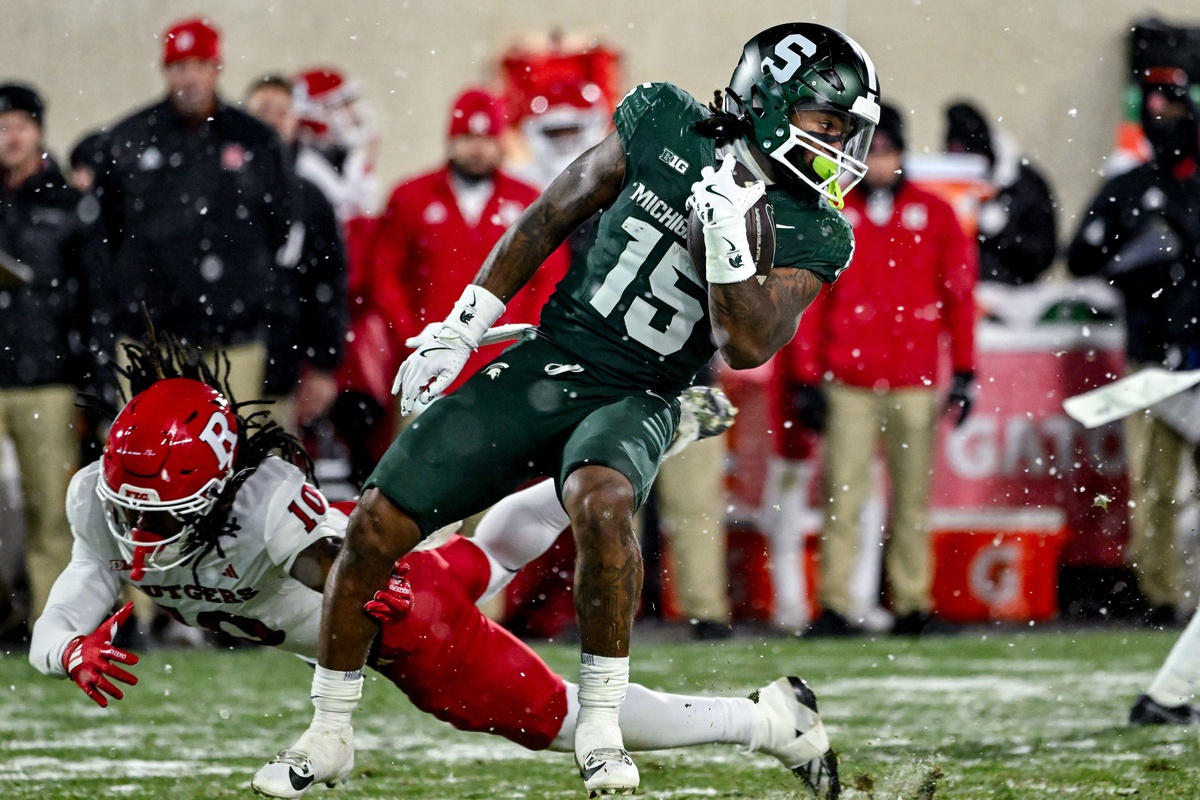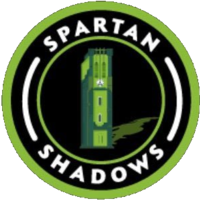Michigan State football, for the final time this year, was back. The Spartans had their last chance to make a statement on the inaugural season for Jonathan Smith, as well as send their seniors off in style by sending them to a bowl game. They hosted a Rutgers Scarlet Knights team that had already clinched a winning record for Greg Schiano, but were looking to improve their bowl seeding. Meanwhile, the Spartans needed this win to make a bowl game for the first time since 2021. With all the motivation in the world, the Spartans ultimately fell flat. They fell to Rutgers, 41-14.
Much like losses to Indiana, Michigan, Boston College, and Illinois, a hot start meant very little after the first few drives.
1. Bad everything: the story of the first half
After an opening-drive touchdown, where the line paved huge holes for Kay’Ron Lynch-Adams and Nate Carter, everything fell apart. Special teams sent a kick out of bounds and fumbled a snap to lead to a quick Rutgers 10-point lead with their short fields.
Later, the defense let up multiple long third-down conversions for the Scarlet Knights to tack on two field goals before half.
Offensively, the Spartans could not get much momentum. A big Nate Carter run was whistled back for holding, and then the Spartans drove to nearly the same field position they lost from the run. Then, on fourth-and-1, Jonathan Smith called a timeout before an Aidan Chiles sneak, and switched it to a Lynch-Adams outside run. The back was stuffed in the backfield, and the defense had their worst drive of the half, letting Rutgers march 94 yards in eight plays.
Normally I could pick out a bad play or a few examples, but it was the whole team. A few bad Ed Woods penalties, a few bad plays by the line, a ball where Ade Willie never got his head around, everything was off for the Spartans. All three phases failed to execute, which has been the mantra of the year.
What is more frustrating for the Spartans is that it is hard to say what can help solve the team’s issues. Aidan Chiles is under pressure right away, and it is hard to tell his progress when he is running for his life on 75 percent of his drop-backs.
On defense, the pass rush is none existent, but the pass coverage is not outstanding either, partially due to being shorthanded. The question facing this staff is, “How do we solve this in the offseason?” and my honest answer is, “I don’t know what to address first.”
At half, the Spartans had run four fewer plays than Rutgers and had nearly 70 yards less, and had let Rutgers go 4-for-4 in the Red Zone while failing to capitalize on their lone chance.
The frustration with this team was real. Outside of the Purdue game, it felt like I was telling myself, “Well, that is the worst half of Michigan State football I’ve witnessed this week. We are still in it.” Then, the second half would strike and all hope would be lost.
2. Injuries kept on piling up
This column feels like déjà vu, as I just wrote on it last week. The Spartans were just as shorthanded this week as they were last week, and then lost defensive back Jaylen Thompson to a scary injury before half. He was carted off, and the Spartans then also lost Cal Haladay to a back injury a few plays later. Thankfully, Haladay returned to play after half on Senior Dat and Thompson was out of the hospital by the time the game ended.
Special teams also saw gunner Caleb Gash limp to the sidelines. It was a nightmare season continued for the Spartans. The injury tent has probably seen more players enter it for the entire season than fans that were in attendance for the finale.
I wish I could have something more unique for takeaways on this team, but it has been the same mistakes and lapses in execution alongside a ton of injuries for the Spartans this year. This year is not a “if they were healthy, they would make the College Football Playoff” case but it is also a case where a 5-7 final record does not reflect the talent of this team. In my opinion, this team would be a 7-5 to 8-4 record if the squad remained healthy the entire year. Even the players that are healthy now, their rhythm and timing is disrupted. Players like Jaron Glover dropping a routine diving catch over the middle would likely not have happened if the receiver was healthy enough to play all of the final three weeks of practices this year.
Also, this is not an excuse for Saturday’s performance. The Scarlet Knights were just as shorthanded as the Spartans, and they put up 23 points on MSU by half. The Spartans let themselves be held down on the mentality of “here we go again.” Aidan Chiles was outspoken about how that attitude will need to change before next season. In his post-game press conference, the quarterback had a lot more of an edge to him than the media usually sees. It is clear that this late season 2-7 finish to the year was unacceptable to the young quarterback.
Thankfully, the Spartans appeared to be injury-free in their final half of football. Unfortunately, it was too little, too late.
3. Second-half offense continues to disappoint
The Spartans’ second half was not much better than their first, with the offense scoring the same amount of seven points and the defense giving up an additional 18 points. The Spartans only outscored their opponent in one second half all season, that being FCS Prarie View A&M, whom the Spartans shut out. That’s right, the Spartans got outscored by every FBS opponent this year after halftime.
Going into next year, this is a change the Spartans need to make. Whether it is revamped analytics, coordinator shifts, or anything else, the Spartans have to make the switch. I understand some of this is a result of trotting out the same five offensive linemen all game with no relief. The Spartan tackle depth was zero for almost the whole season, as Brandon Baldwin bumped in to the offensive guard slot after Gavin Broscious went down, and Rakeem Johnson was a guy the staff wanted to redshirt, so the freshman played sparingly. The injury card is not an excuse card for 11 weeks of failures to win the second half, however.
Scripted Brian Lindgren drives to begin the game resulted in seven first-drive touchdowns this year, with an additional near-score from a missed field goal against Michigan inside the five. However, it appeared offense did not adjust much at half outside of a brief uptick against Iowa after the first bye of the season.
Jack Velling had his best game of the season in the finale, tying his season-high in receiving yards (77, also at Boston College) and his first touchdown in the green and white. Right as the season ends, Aidan Chiles was finally able to get chemistry with his tight end. It is hope for the future, but that is no comfort at the end of the season for Michigan State football. In an offense designed to incorporate the tight end, the first touchdown of the season to that position came in the fourth quarter of the last game.
There are a ton of things that Michigan State football needed to improve on this year, and Jonathan Smith was well aware of it. In his post-game press conference, he stated that he was planning on going after players in a few position groups heavy and also adding depth. While he did not outright say it, I get the feeling that most of us fans are aware of where the Spartans struggled this year.
That is to say that Smith will pursue the offensive and defensive lines, as well as some more depth at a spot like cornerback.
What’s next?
Much like last season, the Spartans enter the offseason facing a lot of questions. This year, they enter with their coach decided, even if the fanbase is torn on him. Give him more than a year, please. The Spartans played three College Football Playoff teams as well as multiple other teams that made appearances in the top 25 polls. This was a harsh schedule, a brutal injury gauntlet, and a brand-new roster.
Michigan State football will not be back until August of next year, when they host Western Michigan on the last weekend of the summer month.

 FOOTBALL2 days ago
FOOTBALL2 days ago
 FOOTBALL21 hours ago
FOOTBALL21 hours ago
 MORE SPORTS7 days ago
MORE SPORTS7 days ago
 FOOTBALL6 days ago
FOOTBALL6 days ago
 BASKETBALL6 days ago
BASKETBALL6 days ago






